
@@@@ What the #$%! Is
AICN COMICS: Q&@? @@@@
@’s by FLASH artist Francis Manapul!
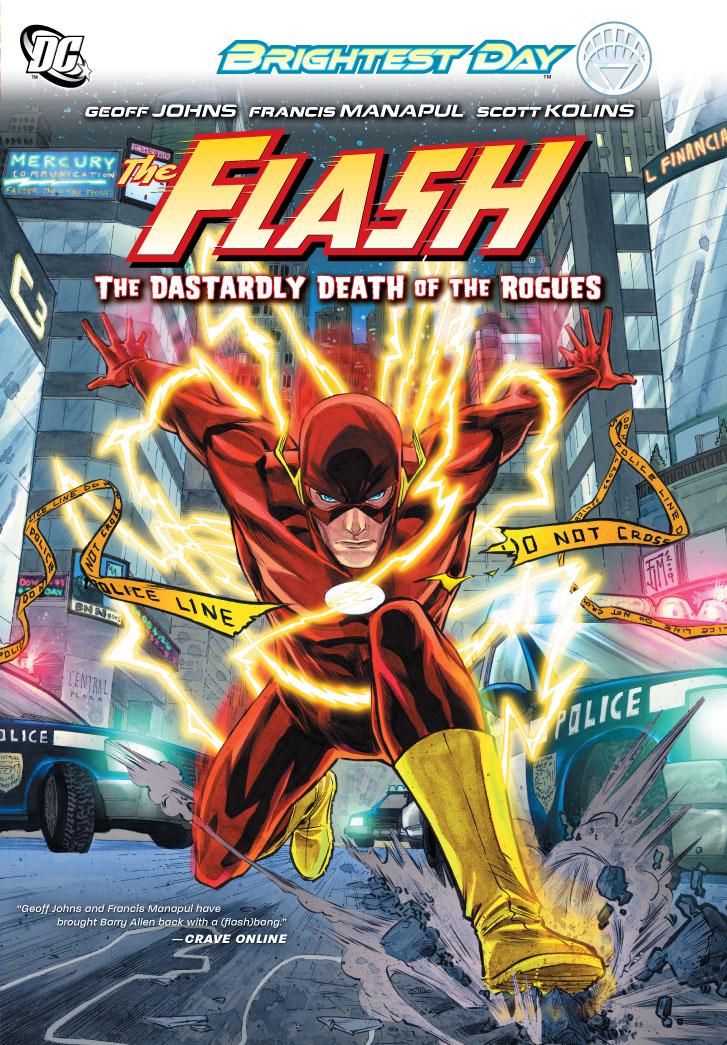 Johnny Destructo here. We’re chatting with Francis Manapul, comic illustrator who’s worked on WITCHBLADE, NECROMANCER for Top Cow, and has been a DC exclusive artist since 2007 and has been done work on BATMAN/SUPERMAN, ADVENTURE COMICS and is the current artist on THE FLASH.
Johnny Destructo here. We’re chatting with Francis Manapul, comic illustrator who’s worked on WITCHBLADE, NECROMANCER for Top Cow, and has been a DC exclusive artist since 2007 and has been done work on BATMAN/SUPERMAN, ADVENTURE COMICS and is the current artist on THE FLASH.JOHNNY DESTRUCTO (JD): First off, I know you’ve probably answered this question too many times, but give us a quick run-down on when you knew you wanted to work in comics and how you got started in the field. I’m sure you have an automated response to this one by now!
FRANCIS MANAPUL (FM): Well, when I was about 15, my cousin introduced me to a lot of these Image guy’s comics, right, and it was the exact same time that Jim (Lee) was working on some stuff, and Whilce Portacio, Marc Silvestri..and the stuff was just really exciting. Beforehand, I had always had a passing interest in comics, and a passing interest in drawing, but the books that they were doing literally leapt off the shelf, slapped me in the face and told me to grab a pencil, it was that exciting. So, from then on, it was just one of those things where I had always been sort of interested in art, and um…art sort of runs in my family, because my mom’s an interior designer and a couple of my uncles are architects, so there were always these draftsmen’s tools all around me, so I started using those and that’s basically it, you know? It was basically born out of excitement for the medium by what a few guys were doing and it just excited something in me to try and give it a shot.
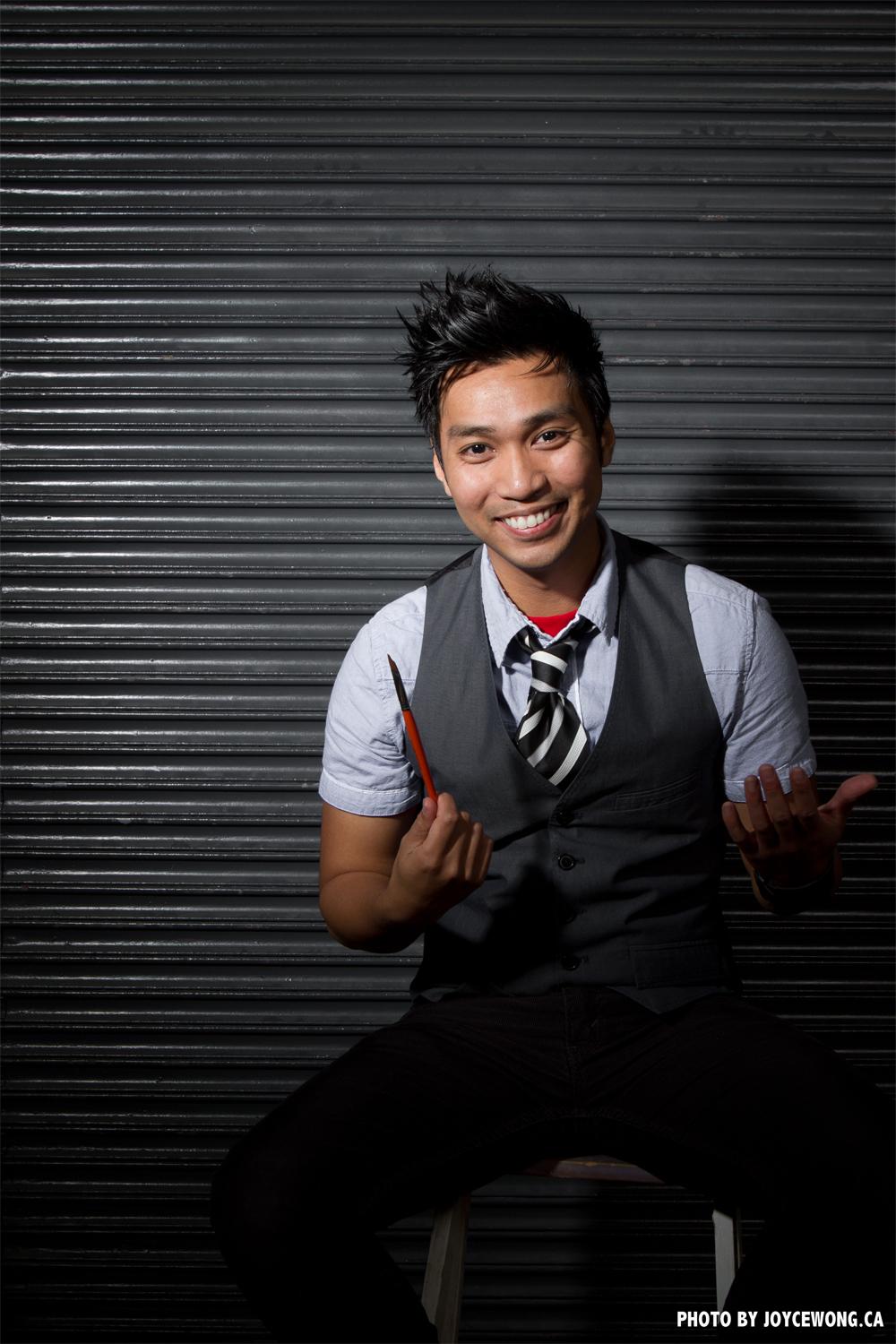 JD: Right on. You mentioned Jim and Whilce and those guys. Growing up, were those the guys you idolized, for the most part?
JD: Right on. You mentioned Jim and Whilce and those guys. Growing up, were those the guys you idolized, for the most part?FM: Yeah, absolutely! The stuff that those guys were doing, like I said, was unlike anything that I had seen before, you know? And when I found out that Whilce was Philipino, I was like “Man, he’s just like me! I have a chance.” and reading the stories on how they broke in, and stuff like that, in Wizard Magazine, just continued to fuel the fire. These guys were just regular guys, you know? And seeing the work that they were doing at the time, the excitement over their stuff, it was just like “wow these guys are superstars” and it’s every kid’s dream, right, to rise out of obscurity and make a living out of something that you’re passionate about. Have something that you’re doing be read, seen and appreciated by a lot of people that was something that was exciting. That was initially in my mind. I would read things, these guys are living the life, making millions of dollars...at least that’s what Wizard said at the time, right?
JD: Yeah, right, (laughs)
FM: (laughs) I like drawing and money, I think I can combine those two things! And right around the time I started putting together my portfolio, I was 17 or so…that’s when the market started to crash, and that was when everything started getting really bad, and when I started showing my portfolio around, nobody was hiring. It just felt like the Depression or something, but at the same time, realizing this, I was still very passionate about the medium and it was just one of those things where some of the first jobs I did were free, and it completely erased out of my head the previous thought that I had, that Wizard told me how profitable it would be as an artist and I just became passionate about the medium. Mind you, later on, it turned back around and stuff was great. I couldn’t complain, I’m happier then ever and at the same time, I’m doing what I love to do.
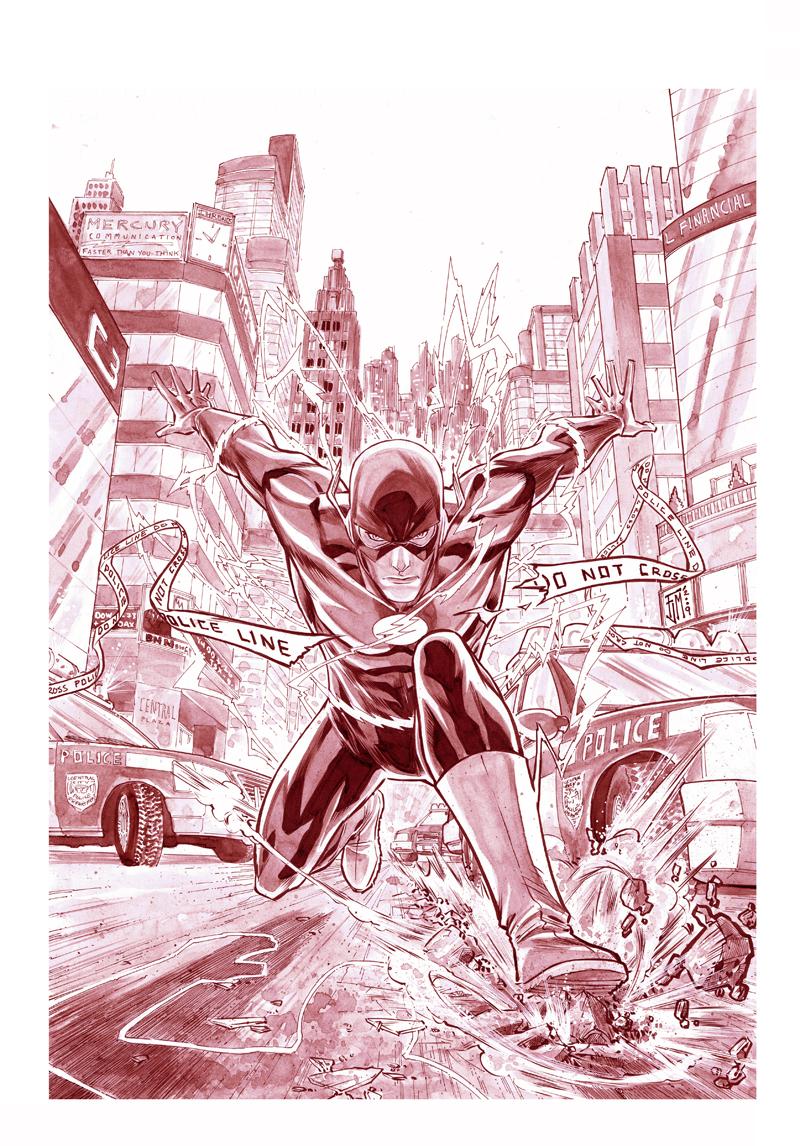 JD: Awesome, that’s a beautiful thing. Now that you’ve been in the industry for awhile yourself, do you have any peers that you’re particularly into?
JD: Awesome, that’s a beautiful thing. Now that you’ve been in the industry for awhile yourself, do you have any peers that you’re particularly into?FM: It’s too broad, I like a lot of artists and as an artist, I feel like there’s something to appreciate in every book. When I was younger, I would look at artist that I wanted to try to emulate…so early on in my career I would try to draw like Jim Lee or Whilce and Mark or Joe Mad. and now it’s different. I’ve kind of discovered who I am as an artist, so my appreciation for different things is a lot broader. It’s really hard to pinpoint who I like now because I’ll look at any art and see something that I like about it.
JD: Yeah I’m the same way. I’m an illustrator myself and everywhere I look, there’s something to pull from and something to really appreciate.
FM: Absolutely, there are a lot of things that inspire me. There’s a lot of artists that I would say are a big influence, but if you look at my art, it shows no semblance of it at all. Like, I’m a big fan of Mike Mignola, alright, but my art doesn’t look like that. Maybe when I was 19 I probably would have attempted to draw like that, if I liked it that much. But it’s just one of those things…from experience, you become your own guy, and what you take from those guys that you’re inspired by is enthusiasm. When I look at what Jim is doing with his Batman stuff, it’s really exciting stuff. And when I look at a guy like Duncan Fregrado, he’s a completely different artist and there’s something to take from that. And a guy like...ah...my brain is just racking up! (Laughs) It feels like my brain is just a matrix of ones and zeros and each one is a different guy that I’m inspired by, you know?
 JD: (laughs) Yeah, right on! It’s difficult! You’re a DC exclusive artist still, is that right?
JD: (laughs) Yeah, right on! It’s difficult! You’re a DC exclusive artist still, is that right?FM: Yeah.
JD: Before THE FLASH, you were drawing ADVENTURE COMICS. Did you know while you were working on that with Geoff (Johns) that you were going to be working on The Flash, or...how did that come about?
FM: No, (laughs) no...how that came about basically was when I was deciding what to do after Legion of Super-heroes, I had been talking to Dan (Didio) and I said “you know, I had asked you approximately 3 or 4 years ago, if I could draw THE FLASH, and the timing just wasn’t right. Is the time right now?”, and he said “You know, it could be...it could be”. I also expressed to him that "more that anything, what is more important to me than what I’m working on is who I’m working with” when I expressed to him an interest in working with Geoff, and I gave him a list of other writers that I would really like to work with, but Geoff was at the very top. It just so happens that at this exact convention, Geoff was there, so Dan talked to him and he seemed to be interested. For awhile there at the beginning, I was like: “Holy Crap, I think I’m about to get the best of both worlds, I think I’m about to work with Geoff and on THE FLASH at the same time.”
But as luck would have it, I think someone beat me to the punch and I think that Geoff promised the book to somebody else, so I agreed to work on ADVENTURE COMICS with Geoff. And...I wasn’t too familiar with the character beforehand, but because of our collaboration, and the way we worked, and where I was taking my art...it was very, very conducive to what I was trying to do. I think that that book is one of the most important books that I had in terms of my development as an artist. And…from that experience, just...as luck would have it, the guy that Geoff had promised the book to backed out, and Geoff was still going to do the book. He was like “Hey, would you like to hop on with me?” I was like “Dude, absolutely! That’s the book that I’ve wanted for so many years!” You know? And to do it with Geoff was such an added bonus. Because any time you’re working on a character that you love with a collaborator that you really enjoy working with, it makes for such a great experience, and right now we’re having such a ball on THE FLASH.
 And it’s good that we had to work on Adventure Comics beforehand, we were able to develop a rhythm, you know, because I feel that when we work together, we’re developing our own little language because when he works with Ivan (Reis) on Green Lantern or with Doug (Mahnke) it’s a completely different kind of story, but when we collaborate on something it’s a completely different vibe. And...I think, after ADVENTURE COMICS and we were able to do the first arc of THE FLASH, you know, in a much more...I guess cohesive way, it almost feels like it’s one mind, and I think that’s what makes this particular story arc so great. It’s literally two guys having a lot of fun, making the Flash do some really, really awesome stuff.
And it’s good that we had to work on Adventure Comics beforehand, we were able to develop a rhythm, you know, because I feel that when we work together, we’re developing our own little language because when he works with Ivan (Reis) on Green Lantern or with Doug (Mahnke) it’s a completely different kind of story, but when we collaborate on something it’s a completely different vibe. And...I think, after ADVENTURE COMICS and we were able to do the first arc of THE FLASH, you know, in a much more...I guess cohesive way, it almost feels like it’s one mind, and I think that’s what makes this particular story arc so great. It’s literally two guys having a lot of fun, making the Flash do some really, really awesome stuff.JD: Speaking of the collaboration between you and Geoff Johns, as far as the script goes, the pacing...there’s a lot of stuff that happens with the Flash, that, you know, as an artist you have to put forth the speed of what he’s doing. Does Geoff set the pace in his scripts for these action sequences, or does he leave it up to you to work out how many panels, and at what speed you want to tell the story of any specific action sequence?
FM: Well the thing is, before we started on the book, before we even started working together, I talked to him a lot about pacing, actually. Even before we discussed story-lines and stuff like that, um…because a lot of times when writers and artists talk, what they talk about is plot and where the story is heading. But before we started the book, I was more about “Hey Geoff, this is the kind of pacing that I like. You know, I like a slow burn, something a little more cinematic.” So when he started writing the script, he definitely put that in mind, because as I’m reading through the scripts and seeing how the pacing is, it’s very much similar to how I would have done it, had I written the story myself.
It’s one of those things where, if Geoff was a girl, I’d put a ring on that finger right now! (Laughs) I think DC did, you know? I know it sounds really cheesy to say, but that’s the truth about it, is that the stuff that he writes is just so...ughhh, you know, that’s not even a word! (laughs)
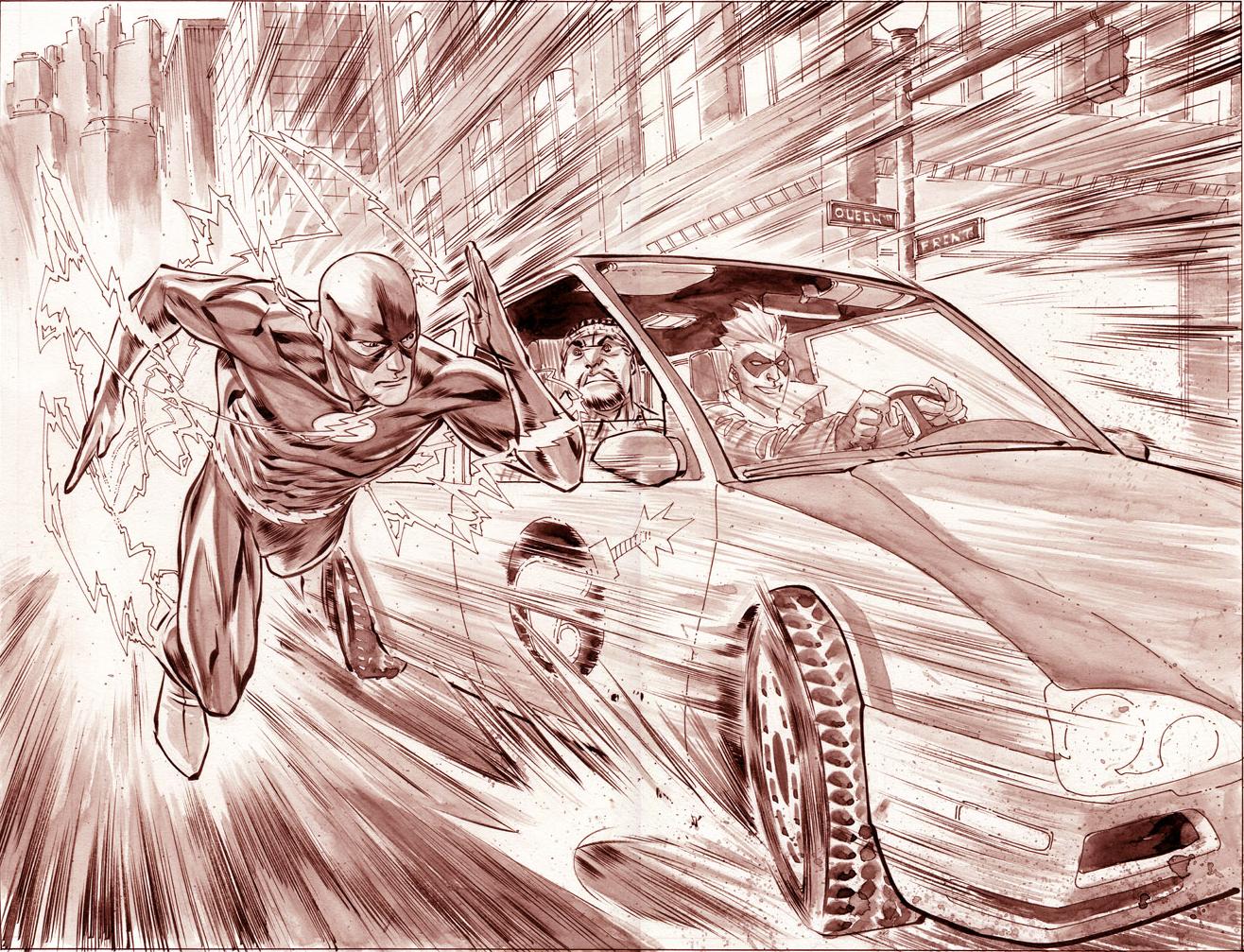 JD: (Laughs) No, no, I agree! He’s one of my favorite writers now!
JD: (Laughs) No, no, I agree! He’s one of my favorite writers now!FM: The way he writes, it feels like he went into my brain and put it on paper, and you know what it is? He’s like a good coach that knows what he’s going to get from his players. He’s not going to make you do what you’re not comfortable with, but he’s going to put you in the exact position you need to be in to win the game. And when he writes those scripts for me, he puts me in those positions to make me look as good as possible. Because there are certain writers that you work with that it just doesn’t mesh with you. But with this particular book with the speed and how we portray that, that was something that we worked really hard on changing up with every issue. We were really adamant that we pulled a new trick, and how it worked out with the pacing and the sequencing of the action was very important. We didn’t want to just add more speed lines and lightening to The Flash. We wanted to create a completely different experience in terms of how you feel speed. We wanted to pull you in and make you feel like you’re running with him, and that was the key goal with how we paced it and it was just such a natural way, it’s hard to boil it down to a science because it just feels right.
JD: Yeah, I can dig it. You mentioned your art style. I saw and interview the other day online, you were talking to someone at a convention, and you were talking about the process of your art style and how you changed it and I noticed that there’s a lot more ink-wash in your work now? What made you decide to do the ink-washing?
FM: Well, I actually use watercolor...
JD: Oh! D’oops, I’m sorry!
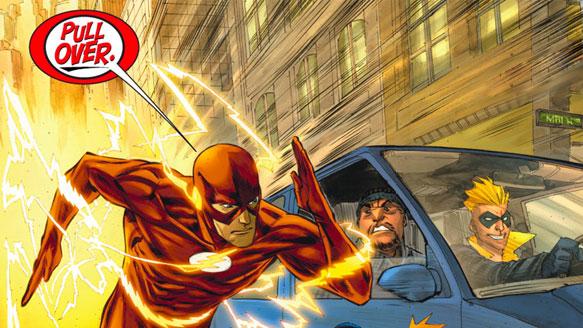 FM: No, it’s fine dude, it’s essentially the same thing, I guess. It’s just washed-down black. Well, when I started out working with Geoff, And I read the script for ADVENTURE COMICS, it was the perfect time to bring out that style that I had been nursing on the side. It wasn’t something that I was sure would work in comic books, it was a little more down-to-earth looking. It wasn’t as...dynamic as regular line-art would be. And ADVENTURE COMICS helped out with that, it’s ...ADVENTURE COMICS was more about still images and quietness and the beauty of the scenery…and The Flash, it’s all about speed and excitement and I think there was a lot of trepidation between how my art work was going to translate on that book and what actually happened was, the way I work helped out even more, because I’m able to do certain tricks with how to portray speed with brushes and grey tones that otherwise I wouldn’t be able to do with a regular pencil or regular black ink. There are a lot of effects that I’m able to do, whether it’s blurring him and showing his speed trails and having the stuff around him in just tones and no inks, there’s so much more you can use. Now, if I were to pencil it regularly, it would feel kind of hindering because right now I feel like I have a broader Utility Belt of tricks that I can use, working this way.
FM: No, it’s fine dude, it’s essentially the same thing, I guess. It’s just washed-down black. Well, when I started out working with Geoff, And I read the script for ADVENTURE COMICS, it was the perfect time to bring out that style that I had been nursing on the side. It wasn’t something that I was sure would work in comic books, it was a little more down-to-earth looking. It wasn’t as...dynamic as regular line-art would be. And ADVENTURE COMICS helped out with that, it’s ...ADVENTURE COMICS was more about still images and quietness and the beauty of the scenery…and The Flash, it’s all about speed and excitement and I think there was a lot of trepidation between how my art work was going to translate on that book and what actually happened was, the way I work helped out even more, because I’m able to do certain tricks with how to portray speed with brushes and grey tones that otherwise I wouldn’t be able to do with a regular pencil or regular black ink. There are a lot of effects that I’m able to do, whether it’s blurring him and showing his speed trails and having the stuff around him in just tones and no inks, there’s so much more you can use. Now, if I were to pencil it regularly, it would feel kind of hindering because right now I feel like I have a broader Utility Belt of tricks that I can use, working this way.JD: That’s awesome because it’s given the book a very unique look, I’m really enjoying it, but...you have a certain time budget when you’re working for a publication. What was your time budget like before you started doing the watercolor and has water coloring really lengthened that process for you?
FM: It’s actually sped it up.
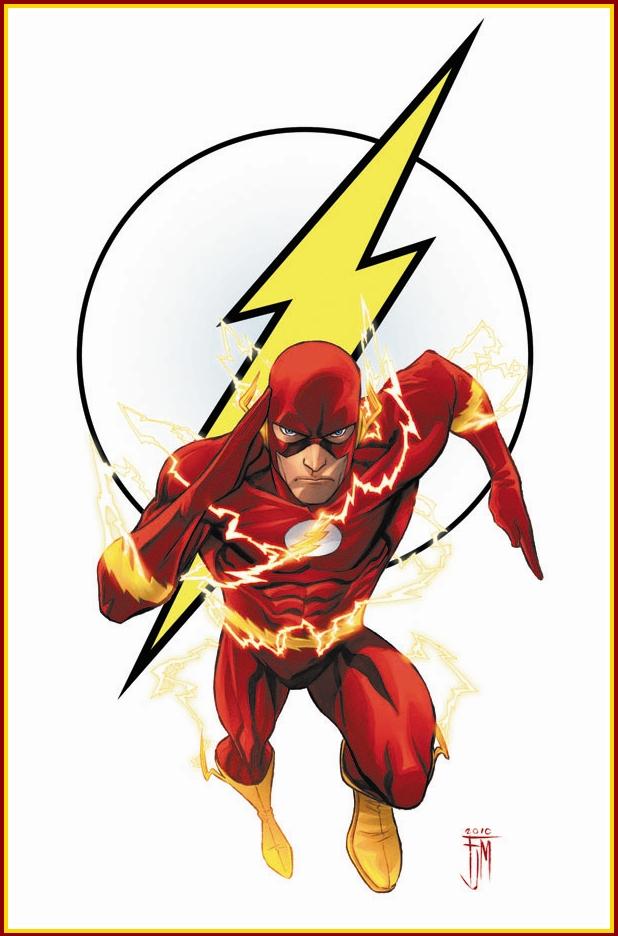 JD: Really?! Huh..
JD: Really?! Huh..FM: Yeah...when I would pencil, I was a very “noodle-y” guy. I would just go in there and noodle and noodle and noodle. (JD’s note: Noodling is a term for how some penciler’s create the form of what they are drawing. Instead of using geometric shapes to make a body, dragging the pencil marks over top of each other to start to create the definition of the body mass) And the thing is, if you have a pencil with only one tip, to get different variations requires a lot of strokes, right?
JD: Yeah..
FM: With a brush, I can get the exact same stroke that might have taken me 50 strokes with my hand, with one stroke…and working the way that I do…I’m not the best inker in the world! (Laughs) So…I’ve had to adapt to the medium and the thing is, when you’re working with brushes, your hand has to move fast, otherwise the lines are going to look crooked, you know? So, working this way is actually faster for me. When I would pencil, I would never be able to do more than a page or a page and a half a day. But, working this way, there are days where I’ve been able to do 3 pages, you know? At most. Right…but that’s kind of stretching it. The next day I’m absolutely useless. But a comfortable pace is basically about 4 to 5 pages a week and that’s usually the schedule that I get. I get about maybe 4 and a half, maybe 5 weeks, a good one, maybe I’ll get six. It really depends. But it hasn’t lengthened it at all. If anything, it’s made it shorter. But if the perception is that it took longer, that’s good right?
JD: (laughs) Huh, that’s amazing. It makes sense, but it never would have occurred to me. A lot of the book takes place in Central City “the city that’s always on the run”...do you use city reference, or do you just kind of make it up as you go?
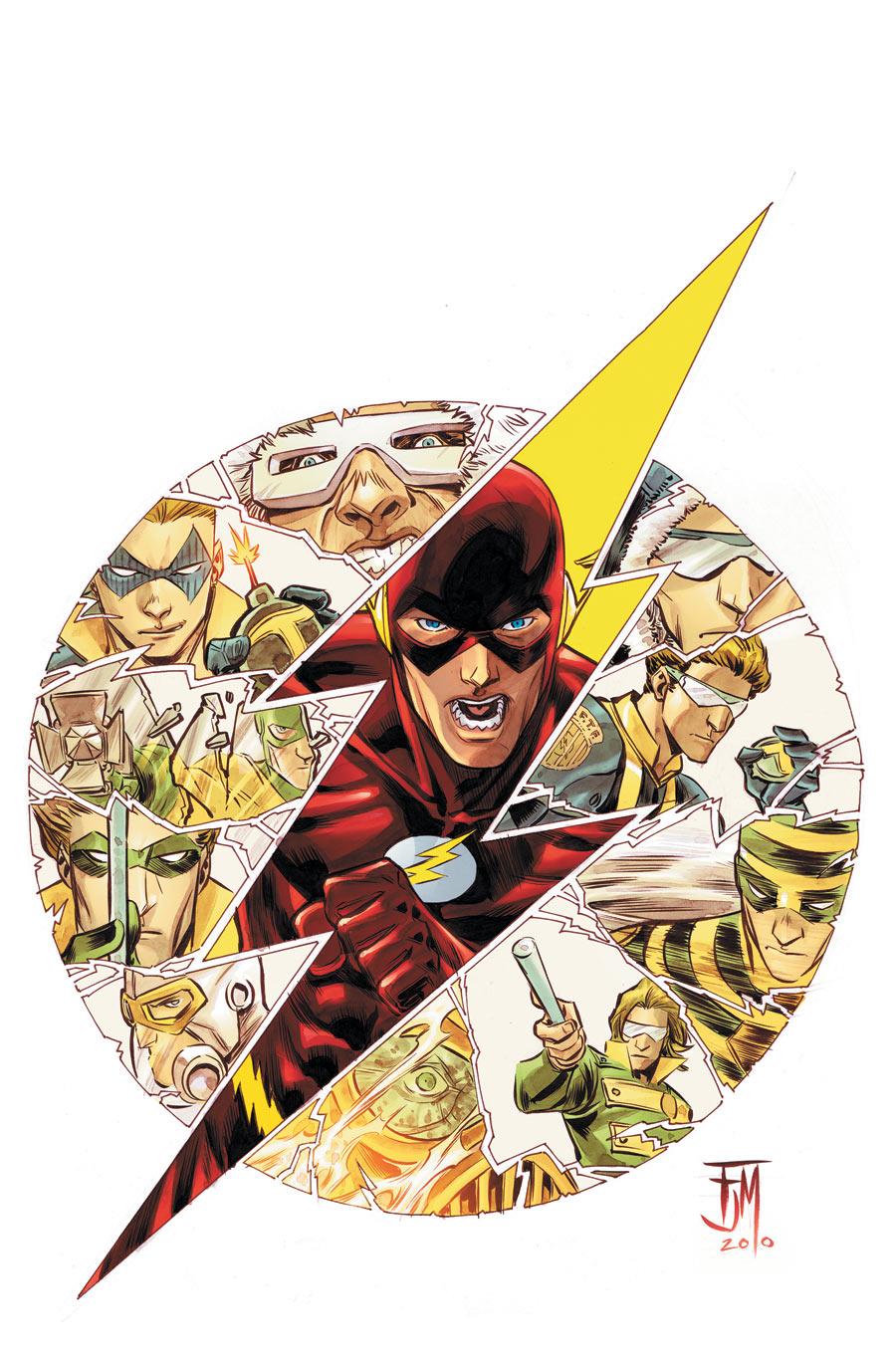 FM: Well, I actually use what I know, because when Geoff sent me references for what he wanted Central City to look like, he sent me pictures of Toronto! (laughs) And...living where I do, I live right in the city, I just look out the window for any sort of inspiration. So, if you live in Toronto and you look through the book, you’ll see some very familiar places. And with Central City playing such a key role, in terms of how we portray Barry as a character, and the contrast between Barry and the city...because you know, when you think about it, Barry is a very methodical, slow and very thorough character. And the Flash himself is obviously a contrast to Barry. But then, if you look at Barry compared to the city, the city is almost to fast for him, right? Everyone is always on the go. So, whenever you look in the background, there’re guys hopping in cabs, people are running here, everyone’s grabbing coffee, there’s a 24/7 (store) everywhere…there are a lot of billboards with telecommunication companies offering faster everything...it’s just one of those things that helps create that environment, that sense of expediency that the people that live there do, right? And like I said, living where I do, all I have to do is walk to the Financial District, stand there and just look at these people scurry off, and hurry up to where they need to be. And just imagining Barry standing in the middle there and seeing all this stuff pass him by, it’s just an interesting contrast to say the least.
FM: Well, I actually use what I know, because when Geoff sent me references for what he wanted Central City to look like, he sent me pictures of Toronto! (laughs) And...living where I do, I live right in the city, I just look out the window for any sort of inspiration. So, if you live in Toronto and you look through the book, you’ll see some very familiar places. And with Central City playing such a key role, in terms of how we portray Barry as a character, and the contrast between Barry and the city...because you know, when you think about it, Barry is a very methodical, slow and very thorough character. And the Flash himself is obviously a contrast to Barry. But then, if you look at Barry compared to the city, the city is almost to fast for him, right? Everyone is always on the go. So, whenever you look in the background, there’re guys hopping in cabs, people are running here, everyone’s grabbing coffee, there’s a 24/7 (store) everywhere…there are a lot of billboards with telecommunication companies offering faster everything...it’s just one of those things that helps create that environment, that sense of expediency that the people that live there do, right? And like I said, living where I do, all I have to do is walk to the Financial District, stand there and just look at these people scurry off, and hurry up to where they need to be. And just imagining Barry standing in the middle there and seeing all this stuff pass him by, it’s just an interesting contrast to say the least.JD: One final question. Optimous Douche and I reviewed the hardcover that just came out. The FLASH hardcover, beautiful work, but..
FM: Thank you.
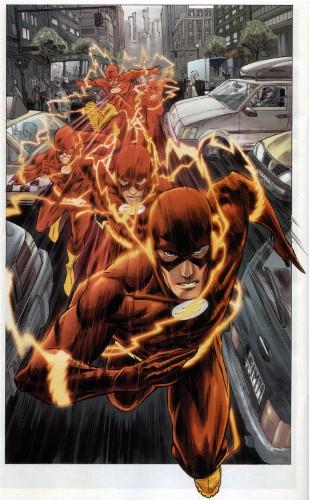 JD: One thing that stuck in our craw was Iris West. She’s drawn to look like she’s in her mid-to-late 20’s? As opposed to...you know...contrasted with Wally and Linda, they seem awful young. Was there a decision to make her younger?
JD: One thing that stuck in our craw was Iris West. She’s drawn to look like she’s in her mid-to-late 20’s? As opposed to...you know...contrasted with Wally and Linda, they seem awful young. Was there a decision to make her younger? FM: Absolutely…
JD: And is there an in-story reason for that, that I’m missing, or...?
FM: I’m sure Geoff will explain it later on. but (laughs) the thing is that...when we started out to do THE FLASH, we wanted it to be a clean palette, but at the same time obviously grounded in continuity. And the thing is that the Speed Force actually effects the age of the people around (Barry). So whether they are getting younger or getting older...there are certain effects that it has, so there’s your explanation. But the thing is, as a reader it’s just a much fresher look and feel for the character and the book when you make them younger. I mean, the dynamics of a young Barry with an older Iris could be interesting, but I think as a new reader, that might be confusing.
JD: Yeah and a bit of a turn-off for younger readers. (laughs)
FM: Right, I mean on the off-hand it’s confusing to current readers...but again, I feel that when you look at our FLASH work, you kind of almost have to look at what they did with the new STAR TREK movie, you know what I mean? It’s still technically in continuity, but it’s younger and fresh. And the thing is, when we started the book, we wanted to spread the Flash love. We wanted to get people that weren’t into the book before drawn to it, and I think that a younger, fresher set of characters would do that. I mean, even the way I draw Barry, he’s younger than I think he was normally portrayed by other artists, and it’s the same thing with Iris, right? So, we’re just trying to keep it a clean palette, yet at the same time there’s still a lot of continuity in there for long-time fans.
 JD: Awesome, well thank you so much for answering all my questions and everything.
JD: Awesome, well thank you so much for answering all my questions and everything.FM: No problem! My pleasure, dude.
JD: You can check out Francis Manapul’s work, in current issues of The Flash and over at his website.
JD can be found hosting the PopTards Podcast, discussing movies, comics and other flimflam over at www.poptardsgo.com, graphically designing/illustrating for a living, and Booking his Face off over here.
Proofs, co-edits & common sense provided by Sleazy G

